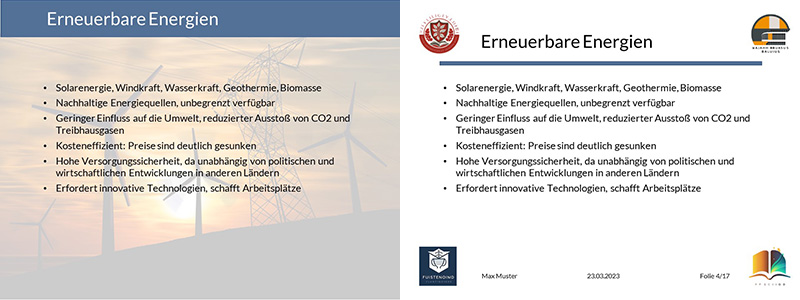A high cognitive load can make learning more laborious. Countless studies have looked into what causes cognitive load and how it can be minimised. What they have revealed is that less is often more.
Cognitive load essentially occurs as a result of the working memory becoming overloaded when processing new information. Possible causes of this are the complexity of the learning content on the one hand (intrinsic load) and a learning environment that is structured unfavourably on the other (extraneous load). Sweller, van Merriënboer and Paas (2019) describe numerous effects that contribute to increasing learners’ cognitive load. This article introduces four of them which seem to be especially relevant to day-to-day university practice.
Overkill | The coherence effect
It is hard to imagine day-to-day teaching without presentation software like PowerPoint, for example. It enables lecturers to put together text, images, videos and animations to create a presentation in a matter of a few clicks. What then frequently ends up in the presentation is information that is interesting but completely irrelevant. Although these elements look good, they divert the learners’ attention away from what is essential. Students also notice logos, the date, slide numbers or their name on the slides (see Figure 1) consciously or subconsciously and these therefore bind cognitive capacities. This increases the cognitive load and makes it harder to identify the relevant information, integrate essential information and connect it up in a way that makes sense.

This coherence effect (Fiorella & Mayer, 2021) is particularly well documented in connection with studies of the effectiveness of multimedia learning environments. A meta-analysis conducted by Sundararajan and Adesope (2020) shows that learning success can be increased significantly when distracting elements are removed from learning materials. Therefore, it is worth going over your own slides again to check that they are not overloaded with irrelevant elements. In the article on “5 typical mistakes in designing slides (and how to avoid them)” you can find detailed guidelines for designing presentation slides so that they are coherent.
The coherence effect also gains traction if slides are visible during a lecture but lecturers explain another topic at the same time – when they digress, for example. In that case, the visual information on the slides does not make sense. On the contrary: because students are dividing their attention between different aural and visual information, the cognitive load increases unnecessarily. Pressing the “B” key (for “black”) or “W” key (for “white”) hides the presentation slides for a short time and makes it easier for your students to listen attentively.
Saying the same thing twice over | The redundancy effect
It is not only distracting details but also the presentation of identical information in different formats that can increase the learners’ cognitive load and lead to poorer learning performance. Here, Sweller, van Merriënboer and Paas (2019) speak of the redundancy effect. This arises where students are working with different information sources at the same time, each of which is self-contained and can also be understood without reference to the others. In this case, students invest completely unnecessary cognitive effort in mentally integrating different sources of information. One example of the redundancy effect is a PowerPoint presentation where a speaker reads out the text shown on the slide word for word during the presentation.
Slight deviations, such as conveying a text presented visually in a way that is largely ad lib, eliminate the redundancy and lead to significantly improved learning success (Fiorella & Mayer, 2021). What is interesting here is that in various studies students preferred the redundant presentation and clearly overestimated their own learning effect in the process. As with the question regarding the preparation of slides in the run-up to a lecture or seminar, subjective preferences do not always match the empirical evidence.
The journey is the reward | Goal-free effect
Cognitive load can be reduced not only by a lecture that has been didactically adapted but also by the type of task assignment. Training problems are usually formulated as a problem involving different parameters and a specific goal. A simple example taken from school teaching shows what is meant here (Paas & Kirschner, 2012):
A car accelerates at a steady pace from a standing position for 1 minute. Its final speed is 2 km/min. How far did it travel in this time?
For novices who solve problems in a way that is backwards orientated, solving this self-contained problem results in high cognitive load. Because they lack models, they have to remember all of the parameters given, the goal and possible solution processes at the same time. Things look different when learners are working with non-specific (goal-free) problems. In the example above, it would look like this:
A car accelerates at a steady pace from a standing position for 1 minute. Its final speed is 2 km/min. With the non-specific goal: calculate as many values as possible.
Here, the goal is non-specific. Students are merely asked to calculate as many values as possible. When they do this, they can concentrate on the different parameters and the connections between them without having to think about a specific goal as well. That means that they can solve the problem in a way that is forwards orientated, which causes significantly less cognitive load.
A study by Trumpower, Goldsmith and Guynn (2004), for example, shows that non-specific training problems can also improve learning for new students in a university context:
students from an introductory course about statistics were given training problems with or without specific goals. The test design was repeated with a control group containing students from an advanced course.
With regard to the new students, those who had learned with the help of non-specific tasks gained more knowledge and were able to transfer this to (specific) tasks they had not seen before better than the control group. In contrast, the non-specific task brought no learning advantage to students with advanced knowledge.

Everything is relative | The expertise-reversal effect
It sounds counterintuitive at first – but it has been well documented empirically: too much didactic support can also affect the learning effect negatively. Didactic aids generally serve to substitute for the lack of cognitive models and support the building of suitable models. Instructions and assistance that may be extremely helpful to new students are sometimes useless or even counterproductive when it comes to experts. The goal-free effect described above, for example, only supports new students, not advanced students. Kalyuga and Sweller (2018) describe this as the expertise reversal effect and name several examples:
- students with little knowledge profit from learning with worked examples, for instance. This effect becomes inverted with increasing expertise, and a greater effect is achieved with forms of learning that are less guided, such as problem-based learning.
- Guidance with regard to applying cognitive or meta-cognitive learning strategies is important for new students and supports learning. Advanced students, however, obtain a better learning effect without this guidance.
- It is easier for new students to learn if complex information is initially conveyed as individual, isolated elements. Experts, on the other hand, would try to align these individual pieces of information with existing models, which increases the cognitive load unnecessarily.
As is so often the case with didactics, there is no solution that fits all problems and every target group. The practice of teaching requires a great deal of instinct for providing as much instruction as necessary and simultaneously presenting as little unnecessary information as possible.
It is often small changes that reduce students’ cognitive load and thus make learning easier. What has been your experience? What adjustments have you made to achieve good learning effects? You are welcome to share your experiences on Twitter or LinkedIn or using the comment function.
References
Fiorella, L., & Mayer, R. (2021). Principles for Reducing Extraneous Processing in Multimedia Learning: Coherence, Signaling, Redundancy, Spatial Contiguity, and Temporal Contiguity Principles. In R. Mayer & L. Fiorella (Eds.), The Cambridge Handbook of Multimedia Learning (Cambridge Handbooks in Psychology, pp. 185-198). Cambridge: Cambridge University Press. doi:10.1017/9781108894333.019
Kalyuga, S. & Sweller, J. (2018). Cognitive Load and Expertise Reversal. In K.A. Ericsson, R.R. Hoffman, A. Kozbelt, A. & A.M. Williams, (Eds), The Cambridge Handbook of Expertise and Expert Performance (pp. 793 – 811). Cambridge University Press.
Paas, F., Kirschner, F. (2012). Goal-Free Effect. In: Seel, N.M. (Ed.), Encyclopedia of the Sciences of Learning. https://doi.org/10.1007/978-1-4419-1428-6_299
Sundararajan, N. & Adesope, O. (2020). Keep it Coherent: A Meta-Analysis of the Seductive Details Effect. Educational Psychology Review 32, 707–734. https://doi.org/10.1007/s10648-020-09522-4
Sweller, J., van Merriënboer, J.J.G. & Paas, F. (2019). Cognitive Architecture and Instructional Design: 20 Years Later. Educational Psychology Review 31, 261–292. https://doi.org/10.1007/s10648-019-09465-5
Trumpower, D.L., Goldsmith, T.E. & Guynn, M.J. (2004). Goal specificity and knowledge acquisition in statistics problem solving: Evidence for attentional focus. Memory & Cognition 32, 1379–1388. https://doi.org/10.3758/BF03206328
Suggestion for citation of this blog post
Hawelka, B. (2023, April 6). Less is more: Four of the many ways to reduce cognitive load. Lehrblick – ZHW Uni Regensburg. https://doi.org/10.5283/zhw/20230406.EN

Birgit Hawelka
Dr. Birgit Hawelka is a research associate at the center for University and Academic Teaching at the University of Regensburg. Her research and teaching focuses on the topics of teaching quality and evaluation. She is also curious about all developments and findings in the field of university teaching.
- Birgit Hawelka#molongui-disabled-link
- Birgit Hawelka#molongui-disabled-link
- Birgit Hawelka#molongui-disabled-link
- Birgit Hawelka#molongui-disabled-link





